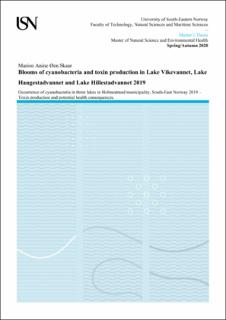| dc.contributor.author | Skaar, Marion Anine Øen | |
| dc.coverage.spatial | Holmestrand | en_US |
| dc.date.accessioned | 2020-12-30T13:50:23Z | |
| dc.date.available | 2020-12-30T13:50:23Z | |
| dc.date.issued | 2020 | |
| dc.identifier.uri | https://hdl.handle.net/11250/2721135 | |
| dc.description.abstract | The occurrence of cyanobacteria in water used for drinking and recreational purposes is a widespread problem around the world. Cyanobacteria have the ability to produce a variety of toxins and this has led to a greater focus on the effects concerning human health. This thesis examines the importance of environmental factors for the occurrence of various cyanobacterial taxa and the production of microcystins and saxitoxin in Lake Vikevannet, Lake Haugestadvannet and Lake Hillestadvannet in Holmestrand municipality in South-East Norway. Potential health risks related to cyanotoxins are also assessed. These lakes are mainly influenced by run-off from agricultural areas and wastewater from dispersed households. The water samples were taken once a month from June to September 2019 (26th June, 29th July, 27th August and 24th September). The water samples were analysed for physical, chemical and biological parameters and the methods were conducted in accordance with the Norwegian standards. The toxins were analysed using a commercial enzyme linked immunosorbent assay (ELISA) technique. Microcystins were detected in all the samples, where the highest concentration was measured in L. Hillestadvannet in June (20,7 μg/L). This exceeds the guideline value for microcystins in recreational waters (10 μg/L) set by the World Health Organization (WHO). According to a risk assesment based on WHO guidelines for microcystins in recreational waters, L. Hillestadvannet shows high risk for adverse health effects in June, while moderate risk in July and August. L. Vikevannet shows mainly low risk, however little is known about the effect of lower concentrations over a long period of time. Saxitoxin concentrations were highest in July, where the highest concentration was measured in L. Hillestadvannet (0,12 μg/L), however there are no guideline values for saxitoxin yet. Chlorophyll a gives an estimate of the phytoplankton biomass in the lakes, and L. Hillestadvannet has the highest average concentration (37,6 μg chl a/L) compared to both L. Vikevannet (16,1 μg chl a/L) and L. Haugestadvannet (24,2 μg chl a/L). This may explain the high toxin concentrations in L. Hillestadvannet. The physical/chemical results indicate good growth conditions for cyanobacteria as they were above the optimum value for cyanobacterial growth, thus leading to dominance of cyanobacteria, especially Microcystis sp., Dolichospermum sp., and Aphanizomenon sp. which were the main species identified in the lakes. L. Hillestadvannet showed N-limitation from June to August, which could lead to a dominance of N₂-fixating cyanobacteria, however Microcystis sp. were the most abundant species independent of the total nitrogen and total phosphorus ratio. Considering the results and studies reporting annual recurring toxin concentrations, it is not justifiable to use the lakes for recreational purposes as there is a possibility of health-related consequences. | en_US |
| dc.description.abstract | Forekomsten av cyanobakterier i vann brukt til drikke- og rekreasjonsformål er et utbredt problem rundt om i verden. Cyanobakterier har evnen til å produsere en rekke giftstoffer, og dette har ført til et større fokus på effektene som berører menneskers helse. Denne avhandlingen undersøker viktigheten av miljøfaktorer for forekomst av forskjellige cyanobakterielle taxa og produksjonen av mikrocystiner og saxitoksin i Vikevannet, Haugestadvannet og Hillestadvannet i Holmestrand kommune. Og vurdere den potensielle helserisikoen knyttet til cyanotoksiner. Disse innsjøene er hovedsakelig påvirket av avrenning fra jordbruksarealer og avløpsvann fra spredte husholdninger. Vannprøvene ble tatt en gang i måneden fra juni til september 2019 (26 juni, 29 juli, 27 august og 24 september). Vannprøvene ble analysert for fysiske, kjemiske og biologiske parametere, og metodene ble utført i samsvar med de norske standardene. Toksinanalysene ble analysert ved bruk av en kommersiell enzymbundet immunosorbentanalyse (ELISA) teknikk. Mikrocystiner ble påvist i alle prøvene, der den høyeste konsentrasjonen ble målt i Hillestadvannet i juni (20,7 μg/L). Denne verdien overskrider retningslinjeverdien for mikrocystiner i rekreasjonsvann (10 μg/L) satt av Verdens helseorganisasjon (WHO). Ifølge en risikovurdering basert på WHOs retningslinjer for mikrocystiner i rekreasjonsvann, viser Hillestadvannet høy risiko for uheldige helseeffekter i juni, mens moderat risiko i juli og august. Vikevannet viser hovedsakelig lav risiko, men det er lite kjent om effekten av lavere konsentrasjoner over lengere tid. Saxitoksinkonsentrasjoner var høyest i juli, hvor den høyeste konsentrasjonen ble målt i Hillestadvannet (0,12 μg/L), men det er ikke satt noe retningslinjeverdi på saxitoksin ennå. Klorofyll a gir et estimat av algebiomassen i innsjøene, og Hillestadvannet (37,6 μg kl a/L) har den høyeste gjennomsnitt konsentrasjonen av klorofyll a sammenlignet med Vikevannet (16,1 μg kl a/L) og Haugestadvannet (24,2 μg kl a/L). Dette kan forklare de høye giftstoffkonsentrasjonene i Hillestadvannet. De fysiske/kjemiske resultatene indikerte gode vekstbetingelser for cyanobakterier, da de var over den optimale verdien for cyanobakteriell vekst. Dette førte dermed til en dominans av cyanobakterier, spesielt Microcystis sp., Dolichospermum sp., og Aphanizomenon sp. som var de viktigste artene som ble indentifisert i innsjøene. Hillestadvannet viste N-begrensning fra juni til august, noe som kan føre til en dominans av N₂-fikserende cyanobakterier, men Microcystis sp. var den mest tallrike arten uavhengig av forholdet mellom nitrogen og fosfor. Tatt i betraktning av resultatene og tidligere studier som rapporterer årlig tilbakevennende toksinkonsentrasjoner, er det ikke forsvarlig å bruke innsjøene til rekreasjonsbruk, da det mest sannsynlig vil få helserelaterte følger. | en_US |
| dc.language.iso | eng | en_US |
| dc.publisher | University of South-Eastern Norway | en_US |
| dc.title | Blooms of cyanobacteria and toxin production in Lake Vikevannet, Lake Haugestadvannet and Lake Hillestadvannet 2019. Occurrence of cyanobacteria in three lakes in Holmestrand municipality, South-East Norway 2019 – Toxin production and potential health consequences | en_US |
| dc.type | Master thesis | en_US |
| dc.description.version | publishedVersion | en_US |
| dc.rights.holder | Copyright The Author | en_US |
